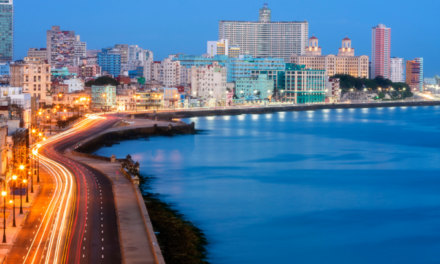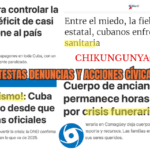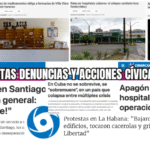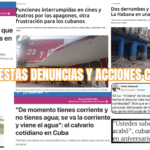How many players from the Cuban National Baseball Series (SNB) have left the country in recent years to play freely and earn the money they deserve abroad?
The exact amount is unknown. In January 2022, Castro’s state-run newspaper “Trabajadores” reported that 635 baseball players “fled” the island since 2016, the highest number among a total of 862 athletes from various disciplines who left Cuba in those six years.
Nor is it known how many Cuban National Baseball Series (SNB) players have left in the 16 months since. Less is known the total number of Cuban baseball players emigrated since pitcher René Arocha gave the starting shot in 1992.
But none of this data surprises anyone. The stampede of Cuban baseball players is the most natural thing in the world. What is news is that with mass exodus, shortages of all kinds, and blackouts, the multisystemic crisis of Castro-communism had not yet checkmated the SNB, but now the collapse seems to be just around the corner.
Stadium with 55,000 seats and only 70 people watching the game
Sports journalist Aliet Arzola posted the following on social networks on May 11 from the Latin American Stadium (del Cerro) in Havana, while watching a game between the capital team Industriales and that of Granma province:
“There are barely 100 people (in the stadium) counting custodians, peanut sellers, press, commissioners; players who were banned from playing today were also present with police.” And he illustrated it with a photo of the great Havana stadium practically empty, taken during the game.
That photo shows the disaster of the Cuban national sport (since the nineteenth century), fulminated by the “revolution”. Nowhere else in the world is it possible to see anything like it: a 55,000-seat stadium with only about 70 or 75 people watching a game of the nation’s strongest baseball.
The game of baseball was Sovietized, enslaving it to a centralized State, ruled by Fidel himself.
The seed of this disaster was sown by Castro when at the beginning of 1962 he banned professional baseball in Cuba, Sovietizing it, and proclaimed: “This is the triumph of free baseball, over enslaved baseball.”
It was exactly the other way around, what the dictator did was enslave Cuban baseball. He killed with a single shot the popular and historic Cuban Baseball League, founded in 1878, and the formidable team “Cuban Sugar Kings” of the International League (Triple A). That Cuban team with an English name was already going to be part of the U.S. Major Leagues and represent Cuba in the best baseball in the world.
The tyrant then created a professional national team disguised as amateurs, to sweep international events and present them as an “achievement of the revolution”, and of himself. And so, baseball became one of the pillars of Castro’s efficient global propaganda machine along with Public Health and Education.
The great fraud of professional teams disguised as amateurs
Castro took great pains to make his state professionals look like amateurs. Each player was assigned a real work center, where they were put on the payroll. However, they didn’t have to report to their “job” and yet they got paid a salary. That is how the pro-ball player appeared as a simple worker who in his spare time played baseball or enjoyed a sports license to play non-professional baseball.
Without detracting from the indisputable quality of many Cuban baseball players, the international championships and gold medals obtained by Cuba since 1962, including 25 World Cups, were an abuse. Cuba participated with experienced professionals with up to 12 and 15 campaigns in the field, to compete with inexperienced amateurs, mostly university students, whom they beat with relative ease.
But when professionalism was allowed in the Olympics and other international events, the Fidelista baseball trick began to deflate. Today Castro’s baseball makes a fool of itself internationally in events in which it doesn’t even win a single game.
Does Castro’s national baseball really have Triple A status?
And something very important, on the island fans have always considered that this ball invented by Fidel has Triple A level status, that is, the highest category after the US Major Leagues.
That may have been true in the early years of the SNB, as most of the players had been trained in professional baseball in Cuba, or in the United States. But that superior level of training began diminishing. And then with professional baseball at all international events, it disappeared. Everything indicates that today Cuban baseball is probably Double A, with some “unpolished” Triple A players. And others with a natural talent for the Major Leagues, although there aren’t so many anymore.
Certainly in the SNB there have been players who in all probability could have shone in the International League (Triple A) and in the Major Leagues of the U.S. Remember Omar Linares, Antonio Muñoz, Marquetti, Capiró, Kindelán, Changa, Urquiola, Anglada, Luis Girardo Casanova, Vinent, Alarcón, German Mesa, Felix Isasi, Urbano González, Antonio Pacheco, Cheíto Rodríguez, Lourdes Gourriel (father), Víctor Mesa, Rogelio García, Juan Castro, and others.
But not everyone on the island has had that great talent. Nor did the SNB really have Triple A level, although some or another team did. Because hitters don’t face 95-100 mile pitchers and scary curves, and pitchers don’t face hitters with the fearsome strength and intense, modern training of today in Triple-A and GL.
Baseball cannot avoid the national crisis that has befallen the country.
These baseball details don’t go to the heart of the problem, which is political. If the Castro regime was able to survive and deceive half the world by sweeping university teams and appearing as the best amateur baseball team in the world, it was because Cuba was financed by the Soviet Union, and then by Chavista Venezuela. That’s over. Caracas no longer sends billions of dollars to Cuba, and barely delivers half, or less, of the oil it has been giving away for 16 years.
Castro’s economy with its genetic parasitism has sunk to levels of hunger and extreme poverty that rival those of sub-Saharan Africa. It has today the level it should have had, if it had not been kept afloat by Moscow and Caracas.
And we are no longer talking about an economic crisis, but a multisystemic one that suffocates the nation. Baseball has no escaping that. It is not worth sketching out the daily calamities that prevent the SNB from functioning normally.
Baseball players on the island want to be free and earn millions of dollars
Baseball players can’t stand their miserable lives and want to play baseball as Free men, not slaves. They want to be millionaires like their Free compatriots.
In the current 2023 season in the Major Leagues, 29 Cubans are playing. Their combined wages exceed all Cuban tobacco exports this year. They are headed by José Abreu, with $ 19.5 million dollars this year; Yasmani Grandal ($18.2); Yoan Moncada ($17.8); Rafael Iglesias ($16.0) and Jorge Soler ($15.0 million).
Conclusion: the regime of Raúl “El Cruel” has no way of impeding the exodus of baseball players, nor will it be able to keep the National Baseball Series standing for much longer if it is not freed from its status as a slave state entity.



























